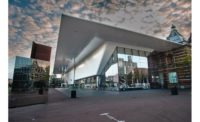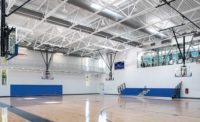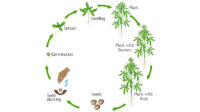Airside economizers are simple, effective systems that significantly reduce cooling energy use and improve indoor air quality. They increase the energy efficiency of the HVAC system to such a high degree that most energy codes require them on commercial applications. The International Energy Conservation Code requires economizers in any system larger than 54,000 Btuh, except for several extremely hot, humid, and cold climate zones.
Sometimes referred to as free cooling, an airside economizer system consists of a set of outside and return air dampers that operate together to reduce the load on the mechanical cooling system (compressors). When outside air conditions are cool and dry enough, the mechanical cooling can be shut off completely and the system can use outside air to cool the building, thus reducing the overall energy use of a facility. Indoor air quality is improved during airside economizer operation. That’s because a greater amount of ventilation air is provided to the occupied spaces than during the minimum outside air mode.
Airside economizers come in various different forms (e.g., temperature-based or enthalpy-based); they’re typically more cost-effective for larger buildings; and they may not make much sense in some climates, especially those that are hot and humid. Economizers operate behind the scenes, and it is difficult to know when they are operating without expensive monitoring instrumentation.
Improvements in Design and Components Ensure Low Cost of Operation
Early indoor pool airside economizers did not always share the same high regard as their conventional HVAC equipment counterparts and were destined for failure because of poor design or improper construction. Sensors, as an example, did not live up to expectations, especially in the corrosive environment of an indoor pool. Quite often, these same sensors received no or few calibrations during their life, adding to the control problem. Sensors were often placed in the wrong location, further limiting economizer performance.
In many occasions, the wrong type of sensors were used. Enthalpy sensors, while measuring total heat content, cannot differentiate the latent from the sensible heat. Knowing the exact latent heat content is crucial since dehumidification is the primary function in a high-moisture indoor pool environment.
Another economizer design flaw involved improperly sized dampers that restricted or limited airflow. Pressurization is also critical. Pool environments, for instance, require a negative pressure to minimize pool odors from infiltrating adjacent office or class areas. Overpressurization will hamper airflow resulting in poor economizer performance.
Studies have shown that enhancing the operation of an economizer system is one of the most cost-effective measures to optimize energy performance and assures a quick payback, often in as little as one year. Components like sensors have greatly improved, and using industrial-grade sensors assures even greater accuracy.
DDC have provided another great leap forward in improving airside economizer performance. Today’s improvements in hardware and firmware allow precise monitoring and control of outside air.
Indoor Pool Economizers
Economizers are best associated with commercial building applications, especially those with cooling loads greater than 50,000 Btuh. These types of economizers are designed and configured for cooling only and are not as concerned about moisture content. Office buildings also have a narrow operating range of about 70°F to 72°F.
Economizing can also be used successfully for indoor pool environments where temperature setpoints are typically 84°F (29°C) with relative humidity at 60%. Many pool dehumidification equipment manufacturers offer economizers as standard or optional equipment, but the majority are for cooling only.
While most economizers operate in a similar fashion, those used with indoor pool dehumidifiers have unique requirements. The indoor pool environment is highly corrosive, resulting in the damage or destruction of critical mechanical components like sensors, dampers, and solenoids.
Many of these same basic economizers are not adequately equipped to balance air temperature over time. When the controller senses the outside air is right for cooling, 100% of the Return Air (RA) is exhausted and replaced by an equal amount of OA. The result can be rapid economizer cooling, followed by reheating once the economizer cycle ends and the compressors restarts.
A better method is a modulating mixing box that allows better control of cooling. OA and RA can be gradually mixed for optimum occupant conditions.
It should also be noted that most large commercial dehumidifiers are designed using heat pump technology allowing for the reuse of the heat captured during the dehumidification cycle to condition the space and/or pool water.
An economizer is an excellent choice for an indoor pool environment for other reasons as well. Since the space setpoint temperature is typically operated at 84°F, OA can be used more frequently and over a more wide range of OA temperatures than in office applications.
OA can also be used for dehumidification and to some degree for heating as well. The control technology plays a key role in analyzing and comparing OA temperature and humidity with RA temperature and humidity and deciding which mode offers the lowest cost of operation to meet setpoint conditions. When you consider that higher-end indoor pool dehumidifiers include all the necessary hardware and firmware for full economizer operation upon delivery, it requires no additional investment to take advantage of these extra features.
ECONOMIZER ENERGY SAVINGS
Specifications
Models: 2 SWHP 190 SR-C units
CFM: 21,000 (per unit)
Capacity: 40 tons (per unit)
Compressor kW: 36.6 Kw (per unit)
The economizer is active 30% of the year in cooling and dehumidifying modes. So 30% of the year, compressor energy is being saved. Assume a 75% mean compressor loading.
At 75% loading, compressor power saved = 0.75 x 36.6 = 27.5 kW/economizer-hr. At $0.14/kW/h, annual savings are:
Compressor Energy Savings
-
75% mean compressor loading x 36.6kW x 30%
-
Annual economizer operation x 8760 Hr/yr x $0.14/kW/h = $10,100 per year.
Fan Energy Penalty
To attain the economizer savings, we need to run our RF, which is 11 kW. If this unit were an SWHP190 supply/exhaust unit (no economizer), the EF would be 5.5 kW. Therefore, the incremental-return-fan-energy penalty for the SR unit to provide the economizer function would be the difference between 11 kW and 5.5 kW, or 5.5 kW. At an 80% load factor, the incremental economizer RF power would be 4.4 kW. The RF economizer-energy-annual-penalty cost would be 4.4 kW X 8,760 X $0.1/kW = $5,400.
Net Energy Savings
Therefore, the net annual economizer savings in this example is $10,100 - $5,400 = $4,700.
Economizer Psychrometrics
A prudent indoor pool dehumidification control strategy is to use an economizer as your first stage of control and not turn on the compressor system. Since the fans are already running, it makes more sense to just open the dampers to maintain conditions.
To better understand the pool room environment, the psychrometric chart can be divided by the indoor pool room setpoints of 84°F and 60% RH, the most frequently used setting for indoor pools. A controls system can use these two setpoints to divide the psychrometric chart into quadrants (Figure 1) along the vertical 84° dry bulb axis line and the horizontal absolute humidity line of 69°F dew point at 84°F and 60% RH. The goal is to have the controller compare the condition of the return air to the setpoint quadrants on the psychrometric chart. Depending on which quadrant the return air dry bulb and dew point temperatures are, the controls determine if the space requires heating, cooling, and/or dehumidification. It is important to note the return air temperature and RH is taken before going through the evaporator.
Cooling Economizer
In this mode, the return air condition is in the bottom right quadrant, meaning the air is too hot but humidity is okay. If the outside air is in either the upper left or lower left quadrants (outside air is cooler than return air), then the controller should slowly open the outside and exhaust air dampers and close the recirculation damper to introduce up to 100% cool outside air into the space.
Cooling and dehumidification economizer
In cooling and dehumidification economizer mode, the return air condition is in the upper right quadrant indicating the air is too hot and too humid (Figure 3). If the outside air is in the lower left quadrant (outside air is cooler and dryer than return air), then the controller should slowly open the outside and exhaust air dampers and close the recirculation damper to introduce up to 100% cool outside air into the space.
Heating Economizer
To utilize the heating economizer, the return air condition is in the bottom left quadrant where the return air is too cold and humidity is okay (Figure 4). If the outside air is in either the upper right or lower right quadrants, where the outside air is warmer than return air, then the controller should slowly modulate open the outside and exhaust air dampers and modulate closed the recirculation damper to introduce up to 100% warm outside air into the space.
Heating and dehumidifying economizer
To use the heating and dehumidifying economizer, the return air condition is in the upper left quadrant where it is too cold and too humid (Figure 5). If the outside air is in the lower right quadrant that means it is warmer and dryer than return air. Under these conditions, the controller should slowly modulate open the outside and exhaust air dampers and modulate closed the recirculation damper to introduce up to 100% warm outside air into the space. The controller should check if the outside air is cooler than the return air, but should be not quite as concerned if the humidity is somewhat higher.
Savings During the Heating Cycle
The economizer function can also be used in other ways to lower the cost of operation (Figure 6). By using an economizer in conjunction with the heat recovery mode of the dehumidification system, heating costs can be reduced even further. Indoor pools typically have high heating demands, and the heat pump operation of the dehumidification stage can satisfy much of these heating requirements.
When the refrigeration loop is running in the heat recovery mode, and the space is calling for heat, the air passing over the evaporator is being cooled to saturation. The sophisticated DDC system measures and compares the condition of air leaving the evaporator with the outside air temperature and humidity.
If the outside air is warmer and dryer than the leaving-evaporator air, the control system will automatically close the recirculation damper and open the exhaust and outside air dampers 100%. All of the cool, saturated air coming off the evaporator coil is exhausted and replaced with 100% of the dryer, warmer outside air. The OA is then passed over the heat recovery hot gas reheat condenser coil where this supply air is reheated with “free” sensible and latent return air heat which was recovered in the evaporator prior to being exhausted.
By using the smart economizing cycle, a significant amount of energy is saved, which can also be used for pool water heating whenever the space temperature is satisfied. Even though the compressors are operating, the smart economizer can save an owner $2,000-$4,000 per year in energy that standard economizer mixing boxes cannot. This smart economizing is only possible if (a) the pool dehumidifier has a mixing box, (b) the exhaust air damper is located downstream of the evaporator and upstream of the hot gas reheat condenser coil, and (c) contains control software that knows what action to take when the proper energy saving conditions occur.
Measuring performance vs. cost
The true test of an economizer is having the ability to track its operation over a meaningful time period. In that way modeling data can be used to accurately predict energy savings. Accurate representation requires hourly analysis of internal loads along with outside environmental conditions. You must know instantaneous cooling, heating, and/or dehumidification load for each hour along with the simultaneous external conditions.
PoolPak has the ability to monitor and collect empirical data on the operation of their newest equipment using an online connection to their new ICC programmable controller that logs economizer operation hourly.
Monitoring was performed on a pool installation located at York College in York, PA. The installation included two model SWHP 190 SR-C units capable of 21,000 cfm with a capacity of 40 tons each. Monitoring was conducted over a one-year period logging economizer operation hourly.
The data concluded that the economizer remained active 30% of the year in both the cooling and dehumidifying modes. After careful analysis considering compressor and fan loading, operation time, and energy cost, the net annual economizer savings came out to $4,700 each.
Periodic Maintenance
Economizer systems are often neglected, and over time, they can degrade to the point that they don’t operate correctly, resulting in energy waste. A little periodic maintenance can help keep them operating correctly.
Economizers, regardless if installed on a pool dehumidifier or conventional HVAC unit, will perform more efficiently if properly inspected and calibrated. Starting with dampers, be sure they are not seizing, a common problem with corrosive environments like indoor pools and salt water locations.
Be sure actuators are adjusted for full closure and linkages are not binding. Improperly positioned dampers can significantly reduce the efficiency of the system due to increased mechanical cooling or heating load because the system is operating with incorrect outside air, return air, and exhaust airflows.
Inspect the unit’s blade and seals for leaks, which can account for as much as 10% of rated damper airflow. Keep the return air and outside air sensors calibrated because they are critical in determining the economizer operating mode.









